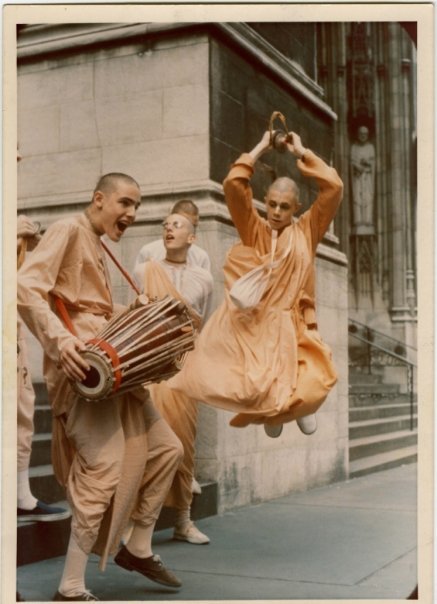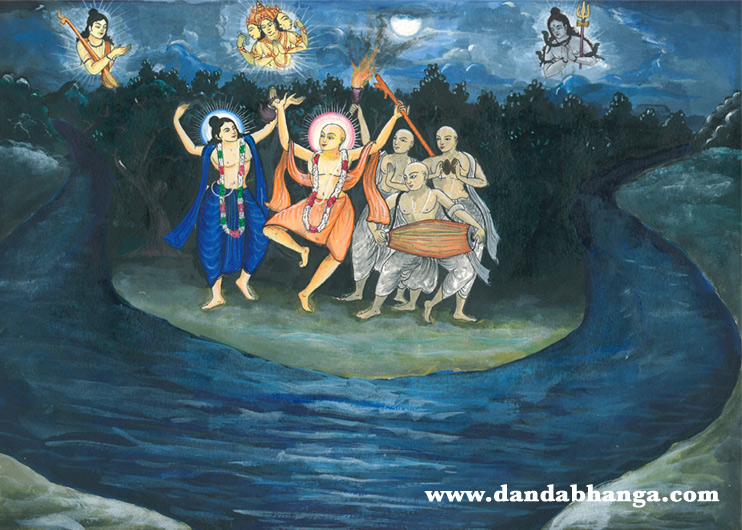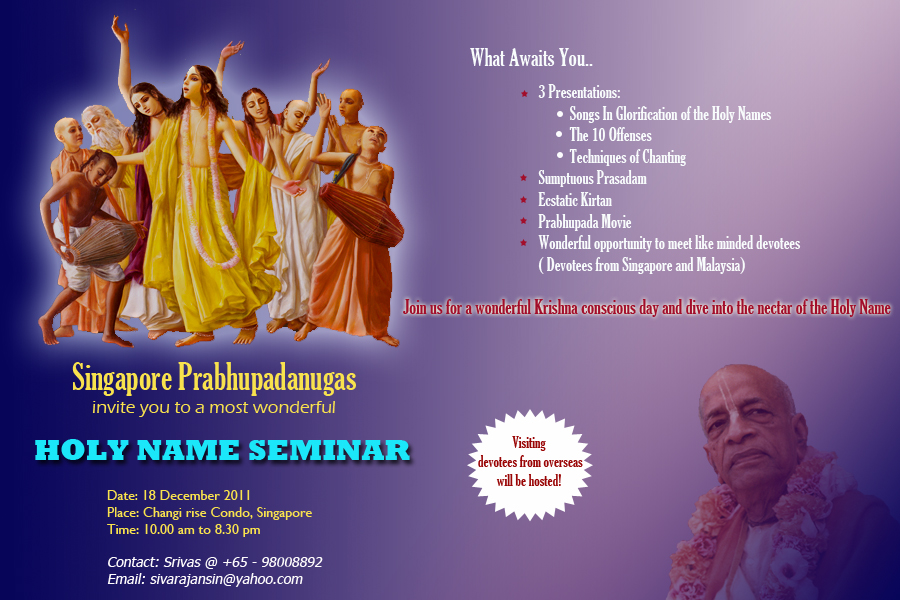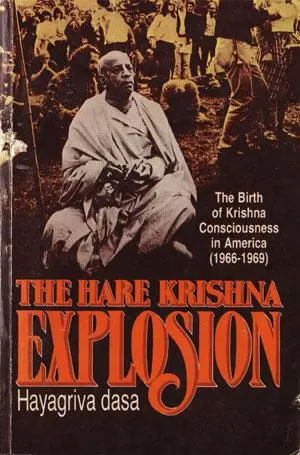17 Jun 2023
by The Hare Krishna Movement
in Bhaktivinoda Thakura, Kabe Ha'be Bolo, Songs of the Vaisnava Acaryas
Tags: bhaktivinoda, chanting Hare Krishna, kabe ha'be bolo, kirtan, krsna consciousness, Srila Bhaktivinod Thakur
Today marks the disappearance day of Srila Bhaktivinoda Thakura. We honor it with a half day fast followed by a nice vegetarian feast. We share with you one of my favorite songs composed by Srila Bhaktivinoda.
When, oh when, will that day be mine?
When my offenses ceasing,
taste for the name increasing,
when in my heart will your mercy shine?
When, oh when will that day be mine?
Lower than a blade of grass, more tolerant than a tree.
When will my mind attain this quality?
Respectful to all, not expecting their honour, then shall I taste the name’s nectar sublime.
When oh when will that day be mine?
More
01 Mar 2023
by The Hare Krishna Movement
in A. C. Bhaktivedanta Swami Prabhupada, chanting, Chanting Hare Krishna, Happening Album, Hare Krishna Maha Mantra, Satsvarupa das Goswami
Tags: A.C. Bhaktivedanta Swami Prabhupada, chanting Hare Krishna, happing album, kirtan, Krishna, krsna consciousness, Srila Prabhupada
Srila Prabhupada Cuts a Record
(from ‘Broadcasting Krsna’s Glories’ by Satsvarupa dasa Gosvami)
“At the studio, everyone accepted the devotees as a regular music group. One of the rock musicians asked them what the name of their group was, and Hayagriva laughed and replied, “The Hare Krsna Chanters.” Of course most of the devotees weren’t actually musicians, and yet the instruments they brought with them — a tamboura, a large harmonium (loaned by Allen Ginsberg), and rhythm instruments — were ones they had played during kirtanas for months.
So as they entered the studio they felt confident that they could produce their own sound. They just followed their Swami. He knew how to play, and they knew how to follow him. They weren’t just another music group. It was music, but it was also chanting, meditation, worship.
More
31 Jul 2017
by The Hare Krishna Movement
in Brahmotsavam, ISKCON
Tags: anniversary of the temples deity installation, arati, Brahmotsavam, ISKCON of central New Jersey, katha, kirtan, Madhupati das, prasadam feast, Shyamsundar das, Sri Sri Radha Shyamsundar

Brahmotsavam 2017
ISKCON of Centeral New Jersey Plainfield
August 5 @ 3:00 pm – August 7 @ 9:30 pm
This is perhaps my favorite ISKCON center in North America. There is a nice mood of service and devotion, and everyone there is very friendly. I would encourage anyone who has not been there to visit next time you are in the area. Hare Krishna! -V
More
16 Aug 2016
by The Hare Krishna Movement
in A.C. Bhaktivedanta Swami Prabhupada, Caaitanya-caritamrta, Caitanya Mahaprabhu, Sri Caitanya-Caritamrta, Srila Rupa Goswami
Tags: A. c. Bhaktivedanta Swami Prabhupada, Antya1.117, Kaviraja Goswami, kirtan, Madhya19.121, mercy of Sri Caitanya Mahaprabhu, sankirtana movement, Sri Caitanya Mahaprabhu, Srila Prabhupada, Srila Rupa Goswami

The Sankirtan Movement of Sri Caitanya Mahaprabhu
Devotees acknowledge Śrī Caitanya Mahāprabhu’s special mercy upon Śrīla Rūpa Gosvāmī in the following words:
śrī-caitanya-mano ’bhīṣṭaṁ-
sthāpitaṁ yena bhū-tale
svayaṁ rūpaḥ kadā mahyaṁ
dadāti sva-padāntikam
“When will Śrīla Rūpa Gosvāmī Prabhupāda, who has established within this material world the mission to fulfill the desire of Lord Caitanya, give me shelter under his lotus feet?”
The special function of Śrīla Rūpa Gosvāmī is to establish the feelings of Śrī Caitanya Mahāprabhu. These feelings are His desires that His special mercy be spread throughout the world in this Kali-yuga.
pṛthivīte āche yata nagarādi-grāma
sarvatra pracāra haibe mora nāma
His desire is that all over the world everyone, in every village and every town, know of Śrī Caitanya Mahāprabhu and His saṅkīrtana movement. These are the inner feelings of Śrī Caitanya Mahāprabhu. Śrī Rūpa Gosvāmī committed to writing all these feelings of the Lord. Now again, by the mercy of Śrī Caitanya Mahāprabhu, the same feelings are being spread all over the world by the servants of the Gosvāmīs, and devotees who are pure and simple will appreciate this attempt. As concluded by Śrīla Kṛṣṇadāsa Kavirāja Gosvāmī, however, those who are on the level of hogs and dogs will never appreciate such a great attempt. Yet this does not matter to the preachers of Śrī Caitanya Mahāprabhu’s cult, for all over the world they will continue to perform this responsible work, even though persons who are like cats and dogs do not appreciate them.
More
14 Oct 2014
by The Hare Krishna Movement
in A.C. Bhaktivedanta Swami Prabhupada, Chanting Hare Krishna, The Hare Krishna Movement, Yoga
Tags: A.C. Bhaktiveanta Swami Prabhupada, chanting Hare Krishna, God realization, Hare Rama, Hari Kirtana, Kali-yuga, kirtan, sankirtan, self relization, supreme absolute truth, Vedic literatures, Visnu

harer nāma harer nāma
harer nāmaiva kevalam
kalau nāsty eva nāsty eva
nāsty eva gatir anyathā
In this Age of Kali there is no other means, no other means, no other means for self-realization than chanting the holy name, chanting the holy name, chanting the holy name of Lord Hari.
[Adi 17.21]
…
This hari-kīrtana was started five hundred years ago in Bengal by Lord Caitanya. In Bengal there is competition between the Vaiṣṇavas and the śāktas. The śāktas have introduced a certain type of kīrtana called kālī-kīrtana. But in the Vedic scriptures there is no recommendation of kālī-kīrtana. Kīrtana means hari-kīrtana. One cannot say, “Oh, you are Vaiṣṇava. You can perform hari-kīrtana. I shall perform śiva-kīrtana or devī-kīrtana or gaṇeśa-kīrtana.” No. The Vedic scriptures do not authorize any kīrtana other than hari-kīrtana. Kīrtana means hari-kīrtana, the glorification of Kṛṣṇa.
So this process of hari-kīrtana is very simple: Hare Kṛṣṇa, Hare Kṛṣṇa, Kṛṣṇa Kṛṣṇa, Hare Hare/ Hare Rāma, Hare Rāma, Rāma Rāma, Hare Hare. Actually there are only three words: Hare, Kṛṣṇa, and Rāma. But they are very nicely arranged for chanting so that everyone can take the mantra and chant Hare Kṛṣṇa, Hare Kṛṣṇa, Kṛṣṇa Kṛṣṇa, Hare Hare. Since we have started this movement in the Western countries, Europeans, Americans, Africans, Egyptians, and Japanese are all chanting. There is no difficulty. They are chanting very gladly, and they are getting the results. What is the difficulty? We are distributing this chanting free of charge, and it is very simple. Simply by chanting, one can have self-realization, God realization, and when there is God realization, then nature realization is included also. (from The Science of Self Realization)
More
12 Feb 2014
by The Hare Krishna Movement
in A.C. Bhaktivedanta Swami Prabhupada, Caaitanya-caritamrta, Nityananda, Sri Caitanya-Caritamrta
Tags: Balarama, carama, elevated devotional service, Gauridasa Pandita, kirtan, krsnadasa, Lord Caitanya, lotus feet, Love of Godhead, Madhava Ghosa, Nityananda, Nityananda Prabhu, The Expansions of Lord Nityananda, vasudeva ghosa

Today we honor the Appearance Day of Lord Nityananda. It is advised that devotees observe a half day fast, and meditate on some of the glories of Lord Nityananda. With this in mind we are posting one nice chapter from the Sri Caitanya-caritamrta describing the Lord and his devotees.
Sri Caitanya-caritamrta 1975 Edition
By His Divine Grace A. C. Bhaktivedanta Swami Prabhupada
Adi-lila Chapter 11
The Expansions of Lord Nityānanda
As the branches and subbranches of Lord Caitanya Mahāprabhu were described in the Tenth Chapter, in this Eleventh Chapter the branches and subbranches of Śrī Nityānanda Prabhu are similarly listed.
More
08 Feb 2014
by The Hare Krishna Movement
in A.C. Bhaktivedanta Swami Prabhupada, Chanting Hare Krishna, Krsna Consciousness, Mantra Meditation, Meditation, The Path of Perfection, Yoga
Tags: A.C. Bhaktivedanta Swami Prtabhupada, Action as Yoga, Bhagavad Gita, chanting and dancing, chanting Hare Krishna, dancing and chanting, Hare Krishna, kirtan, Krsna, mantra meditation, meditation, sankirtan, The Hare Krishna Movement, The Path of Perfection, yoga, yoga system

…In the Sixth and Eighth Chapters of Bhagavad-gītā, Lord Śrī Kṛṣṇa, the Supreme Personality of Godhead, explains that the eightfold yoga system is a means to control the mind and senses. This method, however, is very difficult for people to perform, especially in this age of Kali, an age characterized by ignorance and chaos.
Although this eightfold yoga system is particularly recommended in the Sixth Chapter of Bhagavad-gītā, the Lord emphasizes that the process of karma-yoga, action in Kṛṣṇa consciousness, is superior.
…No one really wants to sit down and meditate. Why should we? We’re meant for positive activity, for recreation, for pleasure. In Kṛṣṇa consciousness, our recreation is dancing and chanting, and when we get tired, we take prasāda. Is dancing difficult? Is chanting difficult? We don’t charge anything to dance in the temple. If you go to a ballroom, you have to pay to enter, but we do not charge. It is natural to enjoy music and dancing and palatable foods. These are our recreations, and this is our method of meditation. So this yoga system is not at all laborious. It is simply recreation, susukham. It is stated in the Ninth Chapter of Bhagavad-gītā (9.2) that this yoga is susukham—very happy. “It is everlasting, and it is joyfully performed.” It is natural, automatic, and spontaneous. It is our real life in the spiritual world. (The Path of Perfection)
Full Chapter More
24 Oct 2013
by The Hare Krishna Movement
in A.C. Bhaktivedanta Swami Prabhupada, Japa, Nectar of Devotion, Practicing Krishna Consciousness at Home
Tags: A.C. Bhaktivedanta Swami Prabhupada, chanting Hare Krishna, holy name, japa, japa bag, japa beads, kirtan, Maha Mantra, mantra meditation

This is such a beautiful picture of Srila Prabhupada with his japa bag, that we thought we would do a short post on ‘japa’.
When a mantra or hymn is chanted softly and slowly, that is called japa. The same mantra, when chanted loudly, is called kīrtana. For example, the mahā-mantra (Hare Kṛṣṇa, Hare Kṛṣṇa, Kṛṣṇa Kṛṣṇa, Hare Hare/ Hare Rāma, Hare Rāma, Rāma Rāma, Hare Hare) when uttered very softly only for one’s own hearing is called japa. The same mantra, when chanted loudly for being heard by all others, is called kīrtana. The mahā-mantra can be used for japa and kīrtana also. When japa is practiced it is for the personal benefit of the chanter, but when kīrtana is performed it is for the benefit of all others who may hear.
In the Padma Purāṇa there is a statement: “For any person who is chanting the holy name either softly or loudly, the paths to liberation and even heavenly happiness are at once open.” (Nectar of Devotion Chapter 9)
Of all the sacrifices, the chanting of Hare Kṛṣṇa, Hare Kṛṣṇa, Kṛṣṇa Kṛṣṇa, Hare Hare/ Hare Rāma, Hare Rāma, Rāma Rāma, Hare Hare is the purest representation of Kṛṣṇa. (from purport; Bhagavad-gita 10.25)
More
17 Sep 2013
by The Hare Krishna Movement
in Bhaktivinoda Thakura, Suddha-bhakata
Tags: bhaktivinoda, devotional practices, enthusiastic devotional service, kirtan, Krsna, Lord Caitanya, Lord Madhava, lotus feet of pure devotees, Songs of the Vaisnava Acaryas, Srila Bhaktivinoda Thakura, suddha-bhakta, tulasi tree

Today marks the appearance day of Srila Bhaktivinoda Thakura. To honor this day, we are posting a very nice song written by Srila Bhaktivinoda entitled “Suddha-bhakta”, and are observing a 1/2 day fast.
The dust of the lotus feet of pure devotees, enthusiastic devotional service, and service to the pure devotees of the highest order are the roots of the creeper of devotion. The holy days like Ekadasi and Janmastami are the mother of devotion for those devotees who respect them. Let the holy places of Krsna’s pastimes be my places of worship, and bless me. May I always visit all the holy places associated with the lila of Lord Caitanya and His devotees. When I hear the sound of the mrdanga in my heart I always desire to join in kirtana; and when I hear the bonafide songs describing Lord Caitanya’s pastimes, my heart dances in ecstasy. Whenever I see the transcendental sri-vigrahas of Radha-Krsna I am in bliss, for by taking Their Lordships’ prasada we can conquer over the material elements. One day while performing devotional practices, I saw my house transformed into Goloka Vrndavana. When I take the caranamrta of the Deity, I see the holy Ganges waters that come from the feet of Lord Visnu, and my bliss knows no bounds. By seeing the tulasi tree my heart feels joy and Lord Madhava (Krsna) is also satisfied. When I eat the prasada favored by Lord Caitanya it is a new life’s experience. (Lord Caitanya was very fond of a green vegetable preparation called sak, and there is another song in this book that tells of the amazing effects of this type of prasada). Bhaktivinoda concludes by saying: “Whosoever attains the stage of enthusiasm for these devotional practices will be supremely blissful wherever he may be.”
Full song lyrics More
03 Jan 2013
by The Hare Krishna Movement
in Chanting Hare Krishna, Quotes by Srila Prabhupada, Sankirtan
Tags: chanting, chanting Hare Krishna, kirtan, life and soul, Madhudvisa dasa, rayarama dasa, sankirtan, Srila Prabhupada, Ssatsvarupa dasa, street chanting

Importance of Hari Nama Sankirtan
Excerpted from letters and lectures by Srila Prabhupada
…I think you should try to always have Sankirtana going on. All other things are subsidiary. This chanting is our life and soul, so we must arrange our program now so that there will be as much chanting on the streets and at college engagements as possible.
…Outdoor kirtana must be done, even at the cost of suspending all editorial work. That is your first and foremost business. Temple worship is not so important. If need be, the whole temple can be locked, but the outdoor kirtana cannot be stopped.
…Your business is not to, I mean to say, satisfy the crowd. Your business is satisfy Kṛṣṇa, and then crowd will be automatically satisfied. We are not going to please the crowd. We are going to give them something, Kṛṣṇa. So you should be very much careful whether you are delivering Kṛṣṇa in the right way. Then they’ll be satisfied. Your only business should be to satisfy Kṛṣṇa.
More
10 Oct 2012
by The Hare Krishna Movement
in A.C. Bhaktivedanta Swami Prabhupada, Chanting Hare Krishna, Nama Sankirtan, Narottama Dasa Thakura, Songs of the Vaisnava Acaryas
Tags: A.C. Bhaktivedanta Swami Prabhupada, haraye namah, kirtan, Krishna consciousness, Lord Caitanya, Mayapur, Navadvipa, sankirtana, sri nama kirtan, Srila Bhaktivinoda Thakur, yadavaya namah

…The Lord ordered all the citizens of Navadvīpa to chant the Hare Kṛṣṇa mantra, and in each and every home they began performing saṅkīrtana regularly.
[All the devotees sang this popular song along with the Hare Kṛṣṇa mahā-mantra.] “Haraye namaḥ, kṛṣṇa yādavāya namaḥ gopāla govinda rāma śrī-madhusūdana.”
When the saṅkīrtana movement thus started, no one in Navadvīpa could hear any sound other than the words “Hari! Hari!” and the beating of the mrdaṅga and clashing of hand bells.
Song lyrics and text More
13 Dec 2011
by The Hare Krishna Movement
in Book Distribution, Diksha, Quotes by Srila Prabhupada, Sankirtan, Siksa
Tags: Book Distribution, books by Srila Prabhupada, Chanting the holy name, guru, Harinama diksa, kirtan, Krsna, sankirtan, spiritual master, spoken kirtans

SRILA PRABHUPADA’S BOOK DISRIBUTION: INITIATING THE WORLD WITH THE HOLY NAME.
This series of Quotes was taken from http://www.prabhupada.org.uk/diksa.htm The author is unknown. Some editing was done by me -V
Srila Prabhupada’s transcendental books are his loud chanting of the holy name. Such loud chanting is giving the people of the world Harinama diksa.
Regarding Sankirtana and book distribution, book distribution is also chanting. Anyone who reads the books that is also chanting and hearing. Why distinguish between chanting and book distribution? These books I have recorded and chanted, and they are transcribed. It is spoken kirtanas. So book distribution is also chanting. These are not ordinary books. It is recorded chanting. Anyone who reads, he is hearing. Book distribution must not be neglected. (S.P.L. to Rupanuga dasa, 19th October, 1974)
When a devotee is perfectly qualified in chanting the transcendental vibration of the holy name, he is quite fit to become a spiritual master and to deliver all the people of the world. The chanting of the holy name is so powerful that it gradually establishes its supremacy above everything in the world. The devotee who chants it becomes transcendentally situated in ecstasy and sometimes laughs, cries and dances in his ecstasy. Sometimes the unintelligent put hindrances in the path of chanting this maha-mantra, but one who is situated on the platform of love of Godhead chants the holy name loudly for all concerned. As a result everyone becomes initiated in the chanting of the holy names–Hare Krsna, Hare Krsna, Krsna Krsna, Hare Hare/ Hare Rama, Hare Rama, Rama Rama, Hare Hare. (T.L.C. Chapter 18)
More
03 Apr 2011
by The Hare Krishna Movement
in Hayagriva das, The Hare Krishna Explosion
Tags: Avalon Ballroom, chant, Fillmore, Golden Gate Park, hayagriva das, hippies, kirtan, Morning Star Ranch, Psychedelic Shop, Sumer of Love, Swamiji

The Hare Krishna Explosion
by Hayagriva das
Part II: San Francisco, 1967
Chapter 10
Soul Struck
During April and May, tourism and hippy fantasy soar to rare heights in the Haight-Ashbury. Like a Mardi Gras carnival, the celebration is cresting, rushing toward some indefinite Ash Wednesday.
Kirtans are wild and uninhibited. We often chant at the Fillmore and Avalon ballrooms, during intermissions between rock groups. A “Summer of Love” festival is organized, and we chant at be-in’s in Golden Gate Park, at the YMCA and Psychedelic Shop, and with hippy sun worshipers at Morning Star Ranch.
The spring passes so quickly, perhaps because its days are filled with long hours of sunshine and festivity. Youths from all sections of the nation roam and lounge throughout the park, barefoot and dungareed, leisurely creating what they hope is a new community of love and peace, a world where no one is over thirty, where there is no violence, ignorance or death. And they chant Hare Krishna because they see ISKCON as an exotic flower in the hippy bouquet, something even further removed from twentieth century America, from the political activists and their endless strife. Generally, activists and Negroes shun us, considering us on far-out trips, dabbling in the cultures of undeveloped nations.
But what do they know of Krishna? Or of Swamiji? What do any of us really know?
More
03 Mar 2011
by The Hare Krishna Movement
in Science of Self Realization
Tags: age of quarrel, chanting Hare Krishna, holy name, Kali-yuga, kirtan, New Vrindavan, Pariksit Maharaja, Science of Self Realization, Srimad Bhagavatam, Sukadeva Gosvami

Krishna Consciousness-The Yoga for the Modern Age
The Science of Self Realization by His Divine Grace A.C. Bhaktivedanta Swami Prabhupada
from the chapter “Practicing Yoga in the Age of Quarrel”
harer nāma harer nāma
harer nāmaiva kevalam
kalau nāsty eva nāsty eva
nāsty eva gatir anyathā
[Adi 17.21]
“In this age of Kali there is no other religion than glorifying the Lord by utterance of His holy name, and that is the injunction of all the revealed scriptures. There is no other way, there is no other way, there is no other way.” This verse appears in the Bṛhan-nāradīya Purāṇa. Harer nāma harer nāma harer nāmaiva kevalam. Simply chant Hare Kṛṣṇa. There is no other alternative. Kalau nāsty eva nāsty eva nāsty eva gatir anyathā. In this age, Kali, there is no other alternative for self-realization. So we have to accept it.
There is another similar verse in the Śrīmad-Bhāgavatam. In the Twelfth Canto, Third Chapter, Parīkṣit Mahārāja was informed by Śukadeva Gosvāmī of the faults of this age, and now all the symptoms of the age of Kali are apparent. In the conclusive portion, however, Śukadeva Gosvāmī said, kaler doṣa-nidhe rājann asti hy eko mahān guṇaḥ: “My dear king, this age, Kali, is full of faulty things, but there is one good opportunity.” What is that? Kīrtanād eva kṛṣṇasya mukta-saṅgaḥ paraṁ vrajet: “Simply by chanting this Hare Kṛṣṇa mantra one can become liberated and go back to Godhead.”
More
03 Mar 2011
by The Hare Krishna Movement
in Devotee Books
Tags: dancing and chanting, hansadutta das, kirtan, KIRTAN Ancient Medicine for Modern Man, kirtan leaders, soul, soul dancing, The Hare Krishna Movement

KIRTAN Ancient Medicine for Modern Man
by Hansadutta Swami
Rare out of Print book written by one on the famous Kirtan Leaders of The Hare Krishna Movement.
“The singing and dancing of Hare Krsna is known as kirtan. My spiritual master Srila Prahupada said; “This is not ordinary dancing: this is the dancing of the soul, a soul awakened to his original consciousness, Krishna consciousness.” There is no motive in performing kirtana. It is the song and dance of ecstasy, the dance of the soul. The soul is dancing: therefore the body is dancing. Actually, the body cannot dance without the soul. A body without the soul is a dead body” (excerpt from book)
This is a beautiful Softbound book that is beautifully illustrated with Color and B & W Plates throughout.
Limited supply! Get one while they last!
* 6 x 9
* 105 pages Softbound cover
* Foreword, Preface, Introduction, Appendixes, About the Author, Supporting References from Vedic Scriptures, Glossary, and Index
This book can be purchased on-line at; http://www.theharekrishnamovement.com
18 Feb 2011
by The Hare Krishna Movement
in Chanting Hare Krishna
Tags: bangalore, Iskcon, japa, kirtan, Krishna, Lord Caitanya, no hard and fast rules for chanting Hare Krishna, Rama, The Hare Krishna Movement
Bsn
You can chant these holy names of the Lord anywhere and at any time, but it is best to set a specific time of the day to regularly chant. Early morning hours are ideal.
The chanting can be done in two ways: singing the mantra, called kirtana (usually done in a group), and saying the mantra to oneself, called japa (which literally means “to speak softly”). Concentrate on hearing the sound of the holy names. As you chant, pronounce the names clearly and distinctly, addressing Krishna in a prayerful mood. When your mind wanders, bring it back to the sound of the Lord’s names. Chanting is a prayer to Krishna that means “O energy of the Lord [Hare], O all-attractive Lord [Krishna], O Supreme Enjoyer [Rama], please engage me in Your service.” The more attentively and sin¬cerely you chant these names of God, the more spiritual progress you will make.
More
07 Dec 2010
by The Hare Krishna Movement
in Chanting Hare Krishna, Devotee's, Hansadutta das
Tags: Ancient Medicine for Modern Man, chanting Hare Krishna, hansadutta das, kirtan, Krishna consciousness, material happiness is temporary, spiritual master, Srila Prabhupada, transcenental happiness

Kirtan: Ancient Medicine for Modern Man
By Hansadutta Prabhu
The singing and dancing of Hare Krishna is known as Kirtan. My spiritual master Srila Prabhupada said, “This is not ordinary dancing; this is the dancing of the soul, a soul awakened to his original consciousness, Krishna consciousness.” There is no motive in performing Kirtan. It is the song and dance of ecstasy, the dance of the soul. The soul is dancing; therefore the body is dancing. Actually, the body cannot dance without the soul. A body without the soul is a dead body.
More































